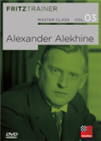An unknown master: Vladimir Petrovs
Latvian chess players know Petrovs but outside of Latvia this strong and talented player is hardly known.
Petrovs was born September 27, 1907 (though some sources give 1908 as the year of his birth) in Riga where he grew up in difficult circumstances and times. Since 1795 Latvia had been part of the Russian empire but on November 18, 1918, after the Russian Revolution and the end of World War I, the country declared its independence. From 1919 to 1920 Latvia was then ravaged by a civil war in which three major fractions fought: German Freikorps, Soviet troups, and Latvian units that supported the civil government. In the summer of 1920 Latvia finally achieved independence after signing treaties with Germany and the Soviet Union, and in 1921/22 the independence of the country was also recognized by England, France, the USA, and Latvia joined the League of Nations.
Vladimir Petrovs' father was a shoemaker who had a small shop, Petrovs' mother was working as a housekeeper. Vladimir Petrovs himself went to grammar school and received a good education. At the age of 13 he and some friends learned chess from the Latvian player Viktors Rosenbergs a Latvian chess legend who once won against Alekhine in a simul. In 1923 Petrovs joined the chess club of Riga, and a year later, in 1924, he won the reserve tournament of the 1. Latvian Chess Congress. In 1925 Petrovs started to study law in Riga but he never finished his studies because he focused more and more on chess.
In 1926, Petrovs won the Championship of Riga. Petrovs had a positional style, and he was inspired by games of strong Latvian players such as Hermanis Karlovich Mattison and Fricis Apsenieks. In 1926 Petrovs finished second at the 2. Latvian Chess Congress but in 1930-1931 he finally won the tournament. In 1931 he became Latvian Champion and in 1934 he shared first with Fricis Apsenieks at the Latvian Championship. Petrovs did not want to have a play-off and gave the title to Apsenieks but in return, they agreed that Petrovs would play first board at the next Olympiads. In 1935 became clear first at the National Championship.
Since the first official Chess Olympiad in 1928 Petrovs had been part of the national team and he played in all Chess Olympiads up to World War II, the last one in Buenos Aires 1939. At the Chess Olympiad 1931 in Prague he was the best player on board one, and in 1939 he won bronze on board one (+8, =11).
In 1937 he played in Kemeri, a spa near Riga, where he shared first place - his greatest success.
Kemeri 1937 - Final Standings
Reshevsky and Flohr advocated to give the winners cup to Vladimir Petrovs — and the Latvian president Karlis Ulmanis gave Petrovs the trophy. For his game against the German master Rellstab Petrovs also received a silver cup donated by the family of Aron Nimzowitsch — for the best game of a Latvian player against a non-Latvian master.
 On this DVD GMs Rogozenco, Marin, Müller, and IM Reeh present outstanding games, stunning combinations and exemplary endgames by Alekhine. And they invite you to improve your knowledge with the help of video lectures, annotated games and interactive tests
On this DVD GMs Rogozenco, Marin, Müller, and IM Reeh present outstanding games, stunning combinations and exemplary endgames by Alekhine. And they invite you to improve your knowledge with the help of video lectures, annotated games and interactive testsAfter his success in Kemeri the international chess press and the other players saw Vladimir Petrovs as "Grandmaster" though this was not yet an official title at that time.
However, Petrovs could never really repeat his success in Kemeri. At the strong eight-player-tournament on the Semmering and in Baden near Vienna in 1937 he finished last. However, in a match between Latvia and Estonia he defeated Paul Keres 1½-½ on board one.

Petrovs vs Keres
At the International Tournament in Lodz 1938 Petrovs shared third place with Erich Eliskases and Gideon Stahlberg. Tenth place went to Mieczysław Najdorf. At Margate 1938 Petrovs again shared third place, this time with Alexander Alekhine and Rudolf Spielmann. However, he managed to beat the World Champion in a fine game.
But at the 2nd International Tournament in Kemeri, in March 1939, he finished in the middle of the field. But immediately after the Olympiad in Buenos Aires he won a tournament of the "Club Espanol" in Rosario (Argentina).
During the Chess Olympiad in Buenos Aires 1939 World War II began. The English team left immediately after hearing the news but most of the other teams stayed in Buenos Aires and finished the event. A lot of players also stayed in Argentina after the Olympiad but Petrovs returned to Latvia which soon was in political turmoil. In 1940 Soviet troops occupied the country and in 1940 Latvia was forced to give up its independence and became part of the Soviet Union - which led to political purges and deportations.
As Latvian Champion Petrovs was invited to the Soviet Championships in 1940 where he finished in the middle of a strong field. In June 1941, when Germany invaded the Soviet Union, Petrovs played in the semifinals of the Soviet Championships in Rostov-on-Don but the tournament was aborted. Petrovs and his countrymen Alexander Koblenz and Janis Fride tried in vain to return to Latvia which had been occupied by the Germans. Petrovs went to Moscow where he took part in the city championship at the end of 1941. He became second. Later, Petrovs was evacuated to Sverdlovsk where he played another tournament and again finished second - behind Ragozin.
During this tournament, Petrovs probably made derogatory remarks about the situation in Lativa after the communist takeover. He was denounced and on August 31 the NKVD arrested him. Petrovs was accused of anti-soviet statements and interrogated for two weeks. After five more months in prison he was sentenced to ten years hard labour and on February 3, 1943 he was sent to the Gulag in Workuta where he died on August 26, 1943 from pneumonia. His name was more or less erased from Soviet chess publications. His wife Galina tried her whole life to find out what had happened to her husband but for a long time his fate remained unknown. Only in 1989, when the files of the KGB were opened, he was rehabilitated.
In 2012 Alexei Shirov organised a Petrovs Memorial tournament in Riga to honour the Latvian player.
Translation from German: Johannes Fischer
























